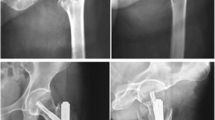Abstract
Introduction
Locked intramedullary nailing continues to be the surgical treatment of choice for most long bone fractures. Performing distal interlocks can be a technical challenge. Free hand (FH) technique remains to be most popular. Radiation exposure, particularly to the surgeon still remains a concern with this technique.
Method
A prospective randomized analysis of 20 patients undergoing operative fixation with long trochanteric fixation nailing for intertrochanteric or subtrochanteric fractures was performed. The groups were randomized into (1) aiming arm group (AA) and (2) FH group by computer generated randomization technique. Two distal interlocking screws were placed in every case. Various parameters were analyzed including total operating time, distal interlocking time, total fluoroscopy time, distal fluoroscopy time and nail dimensions. The variables in two groups were compared to each other using Fischer’s exact test.
Result
The mean distal interlock time was 7.1 ± 2.4 and 12.1 ± 3.2 min for AA and FH techniques respectively. There was a 41.3% decrease in the distal interlock time with the device, which was statistically significant (P < 0.001). The distal interlock fluoroscopy time was 9.2 ± 4.9 and 28.9 ± 16.4 s with AA technique and the FH technique respectively. This 68.2% reduction in time taken for distal fluoroscopy was statistically significant (P < 0.001). However, the reduction in the total fluoroscopy time was statistically not significant.
Conclusion
The AA is very efficient and user friendly and also reduces the radiation exposure.




Similar content being viewed by others
References
Barrick EF (1993) Distal locking screw insertion using a cannulated drill bit: technical note. J Orthop Trauma 7(3):248–251
Barry TP (1984) Radiation exposure to an orthopedic surgeon. Clin Orthop 182:160–164
Conlan DP (1990) Grosse and Kempf locked intramedullary nailing: an improved distal locking screw drill guide. J R Coll Surg Edinb 35(1):61
Goodall JD (1991) An image intensifier laser guidance system for the distal locking of an intramedullary nail. Injury 22(4):339
Hashemi-Nejad A, Garlick N, Goddard NJ (1994) A simple jig to ease the insertion of distal screws in intramedullary locking nails. Injury 25(6):407–408
Hudson I (1989) Locking nailing: an aid to distal targetting. Injury 20(3):129–130
Klein MP, Rahn BA, Frigg R, Kessler S, Perren SM (1990) Reaming versus non-reaming in medullary nailing: interference with cortical circulation of the canine tibia. Arch Orthop Trauma Surg 109(6):314–316
Krettek C, Konemann B, Miclau T, Kolbli R, Machreich T, Kromm A, Tscherne H (1998) A new mechanical aiming device for the placement of distal interlocking screws in femoral nails. Arch Orthop Trauma Surg 117(3):147–152
Krettek C, Konemann B, Miclau T, Kolbli R, Machreich T, Tscherne H (1999) A mechanical distal aiming device for distal locking in femoral nails. Clin Orthop 364:267–275
Krettek C, Konemann B, Miclau T, Schandelmaier P, Blauth M, Tscherne H (1997) A new technique for the distal locking of solid AO unreamed tibial nails. J Orthop Trauma 11(6):446–451
Krettek C, Mannss J, Konemann B, Miclau T, Schandelmaier P, Tscherne H (1997) The deformation of small diameter solid tibial nails with unreamed intramedullary insertion. J Biomech 30(4):391–394
Krettek C, Mannss J, Miclau T, Schandelmaier P, Linnemann I, Tscherne H (1998) Deformation of femoral nails with intramedullary insertion. J Orthop Res 16(5):572–575
Madan S, Blakeway C (2002) Radiation exposure to surgeon and patient in intramedullary nailing of the lower limb. Injury 33(8):723–727
Mehlman CT, DiPasquale TG (1997) Radiation exposure to the orthopaedic surgical team during fluoroscopy: “how far away is far enough?”. J Orthop Trauma 11(6):392–398
Miller ME, Davis ML, MacClean CR, Davis JG, Smith BL, Humphries JR (1983) Radiation exposure and associated risks to operating-room personnel during use of fluoroscopic guidance for selected orthopaedic surgical procedures. J Bone Joint Surg 65(1):1–4
Pardiwala D, Prabhu V, Dudhniwala G, Katre R (2001) The AO distal locking aiming device: an evaluation of efficacy and learning curve. Injury 32(9):713–718
Rahman MM, Taha WS, Shaheen MM (1998) A simple technique for distal locking of tibial nails. Injury 29(10):789–790
Sanders R, Koval KJ, DiPasquale T, Schmelling G, Stenzler S, Ross E (1993) Exposure of the orthopaedic surgeon to radiation. J Bone Joint Surg 75(3):326–330
Skjeldal S, Backe S (1987) Interlocking medullary nails–radiation doses in distal targeting. Arch Orthop Trauma Surg 106(3):179–181
Stedtfeld HW, Jurowich B, Baumer F, Ertel R (1990) Laser focusing device for the distal locking of intramedullary nails. Chirurg 61(6):469–472
Steriopoulos KA, Kontakis GM, Katonis PG, Galanakis IA, Dretakis EK (1996) Placement of the distal locking screws of the femoral intramedullary nail without radiation. Arch Orthop Trauma Surg 115(1):43–44
Viant WJ, Phillips R, Griffiths JG, Ozanian TO, Mohsen AM, Cain TJ, Karpinski MR, Sherman KP (1997) A computer assisted orthopaedic surgical system for distal locking of intramedullary nails. Proc Inst Mech Eng 211(4):293–300
Wu CC, Shih CH (1992) Biomechanical analysis of the mechanism of interlocking nail failure. Arch Orthop Trauma Surg 111(5):268–272
Author information
Authors and Affiliations
Corresponding author
Rights and permissions
About this article
Cite this article
Boraiah, S., Barker, J.U. & Lorich, D. Efficacy of an aiming device for the placement of distal interlocking screws in trochanteric fixation nailing. Arch Orthop Trauma Surg 129, 1177–1182 (2009). https://doi.org/10.1007/s00402-008-0710-y
Received:
Published:
Issue Date:
DOI: https://doi.org/10.1007/s00402-008-0710-y




